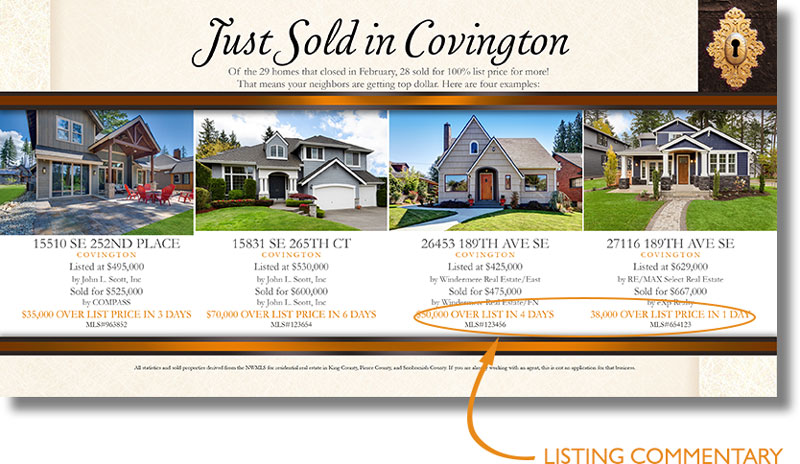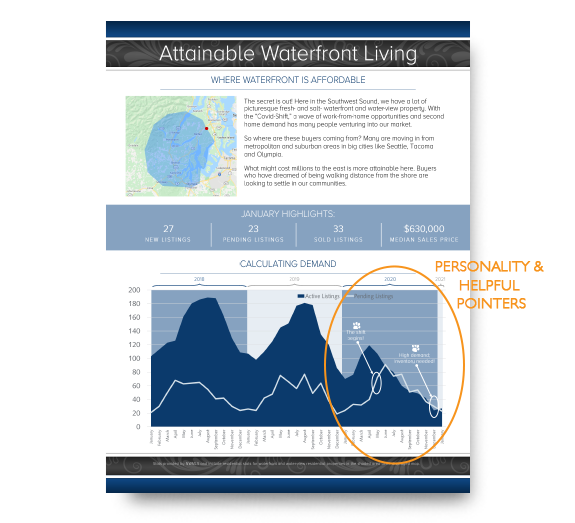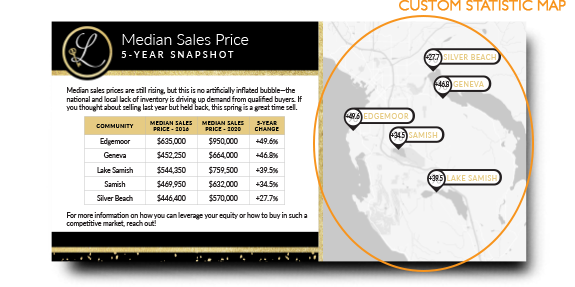
Developing a consistently-producing farm is a great way to develop a reliable income stream. But what are the individual components that deliver the greatest likelihood of success? All too often, agents begin a farm with the best of intentions, but quickly lose momentum if that farm doesn’t produce expected results right away. Especially in this market, patience and persistence are key! In all my years, I have never met an agent who didn’t have strong long-term success who followed the principles below.
Even if you have a farm already, consider incorporating some of my ideas. Here are my 5 actions that anyone developing a farming plan should take:
1. Turnover Rate
Once you have an area or two or ten in mind, take a look in the MLS to make sure the area has historically been strong in terms of sales. I say historically because the last few years are not a good gauge for an area’s sales potential. In a more-balanced market, I would recommend reviewing the turnover rate annually for the last three years and focusing on areas that got a 7% turnover rate or higher.
How does one determine the turnover rate? By taking the number of solds in an area in a given year and dividing by the number of homes in that area (if you can’t get the number of homes from your MLS, try contacting a title company, lender, or a direct marketing company).
For example, if you have 7 homes that sell in an area with 100 homes:
7 / 100 = .07 = 7% turnover rate
It is not atypical to see a much lower turnover rate in recent years. I suggest now going back FIVE years and finding the turnover rate per year. If you had 7% in 2016 and are down to 2-3% now, those are decent numbers. Anything less than this may take you longer to see results.
2. Area and/or Niche Identity
One detail that can be overlooked is including the identity of the area in your campaign. Having a newsletter called The Farm Area Report makes a statement – it says, “the information in this report is relevant to you.”
When I was selling, my first farm area was called Guilford Muse which was a collection of townhomes. The newsletter I created was the Guildford Mews News. It got attention right away as I only included information on those townhomes and the surrounding neighborhood market. I didn’t focus on what was happening in greater Vancouver area – that was too big and irrelevant to my little group of townhomes.
If you are working an area without an identity, that might prove problematic – unless like you are like my client, Andrea Fjortoft. The neighborhood she chose to target was between a few strongly-identified neighborhoods, but the pocket she had chosen didn’t. In her first series of mailings, she put out the call to name their area. After much neighborhood discussion, they chose an identity and Andrea put her mark on that farm area.
3. Campaign Consistency
One common question I get is about the campaign frequency. My recommended farming program includes – at a minimum – a 6.5 x 9 postcard mailed monthly. However, agents like to get creative and they like to save time and money. For agents who are in that category, I recommend doing a very robust quarterly report – I am talking a four-page, in-depth quarterly report. That is the MINIMUM I would recommend any agent do in terms of consistency. If you aren’t even going to do that, don’t waste your money.
4. Personality-Proof Your Campaign
It is important to remember that people of all personalities will be receiving your materials – those who need numbers, those who need it to be visually-strong, those who want to hear what YOU have to say, and those who want to hear stories and see photos of people. In order to be most-effective, all of these must be incorporated into your mailers. Here are three content rules to follow:
- Add your personality – the mailers having the most impact include a strong agent personality component and a personal touch. That includes a friendly photo of you or better yet, a friendly photo of you in your farm area! That also includes a message or call-to-action in your voice, perhaps designated so by a friendly script font. If a graph or numbers are included, circle important information and explain what trends you are seeing. A little personality goes a long way when building relationships by mail.

- Include local statistics that are not easily available on your MLS – Anyone can get online and see what is happening in their town or zip code, but when you are the neighborhood expert, your readers expect a little more. Learn how to use your MLS to provide neighborhood stats including median sales price trends, active and pending trends, and days on market. Also, don’t be afraid to show interesting interpretations of the data. For example, the days on market average might have been 12 last month, but you may want to point out that 6 of the 9 properties sold went under contract in fewer than 6 days. These statements work well, especially if you have an outlier that is throwing off the data (not atypical for a smaller area).

- Include local sold properties with commentary if your MLS allows it – People are always curious about what their neighbors sold for. Sold properties also provide proof – proof that the trends they are hearing about in the news and possibly in your mailers have been achieved by someone in their neighborhood. Including neighborhood sold properties including list price, sales price, days on market along with address and whatever other information you want or are required to include is a MUST for farm mailers in my opinion.

5. Find Opportunities to Build Relationships with Layers
I love finding opportunities to add layers in a campaign because it increases the likelihood of being remembered. Do you remember ever seeing an ad time and time again but then you saw it in another context and thought, “I remember that!”? You can put this idea to work in your farm area too! Here are just a few opportunities that arise in most farm areas:
- When you list a property – send a letter
- When you pend a property – send a letter
- When you sell a property – send a letter
- When you have an open house – send a letter
- When there is an expired or cancelled listing – send an information packet or utilize an expired listing campaign
- When there is a FSBO – send an information packet or utilize a FSBO campaign
- When there is a zoning change – send a letter
- When someone is past due on their property taxes – send a letter
- When someone has a lot of deferred maintenance and may not be able to maintain their property any longer – send a letter
- When someone has lived in their home for 10, 15, 20, 25 years – send an anniversary card and a property report
Can you see how you can quickly become the go-to resource for all things real estate when you add layers in your campaign? Choosing one of these or even just the first three as outlined in my Neighborhood New Listing Letter Series makes a huge difference to the effectiveness of your campaigns!
Although I have covered a lot of information today, it is all very doable. The key is to jump in with both feet and commit. If you think you only have a few mailers in you, then perhaps focus on expired listings or a lead generation opportunity that works more like a faucet that you can turn on and off than an ongoing commitment.
Let’s not forget what I think is the MOST IMPORTANT COMPONENT of developing a strong farm campaign and that is making sure EVERYTHING you send out is on your MEMORABLE BRAND. This is not the time to rely on your company’s brand where you play second fiddle to the company message (which is usually too generic for effective farming anyway). Will it cost you more in time or money to create your own custom newsletter on your own brand? YES! But remember, you are building trusting relationships with people. It is easy to ignore or throw something away that feels corporate. Generic and corporate doesn’t do it when it comes to marketing these days! It is time to throw away that security blanket and create a campaign that is completely your creation with your strong brand, voice, data, and calls-to-action.
If you haven’t guessed already, The Lones Group are pros when it comes to creating compelling brands and campaigns. If you are thinking about starting a farm area, are ready to build that brand that turns heads, and need a little help, we are the company to turn to.
How does it work?:
First, our in-house (well, working from home locally) design team will build you a custom brand that is unique and can act like a marketing megaphone for you!
Then, we can apply that brand to about anything – Do you need listing presentation materials? A new farm campaign? A series of letters targeted to landlords who haven’t been receiving rent and may want to sell? Want us to create an ad to go on the back window of your car? Want to build an ad banner that is flown by an airplane? The great thing about working with us is we are never short on ideas for your business, we have worked with real estate agents across the country, and our team is backed by decades of industry experience that focuses on RESULTS.
Learn more and we hope to chat with you soon!
By Denise Lones CSP, M.I.R.M., CDEI – The founding partner of The Lones Group, Denise Lones, brings nearly three decades of experience in the real estate industry. With agent/broker coaching, expertise in branding, lead generation, strategic marketing, business analysis, new home project planning, product development, Denise is nationally recognized as the source for all things real estate. With a passion for improvement, Denise has helped thousands of real estate agents, brokers, and managers build their business to unprecedented levels of success, while helping them maintain balance and quality of life.






 Posted in
Posted in  Tags:
Tags: 

Hi Denise,
Great article on farming. When I started farming (and didn’t know anyone in the farm), I would load a wagon and my four-year old son in the car. I’d walk the neighborhood pulling the wagon with my son inside. I got exercise and he got a free ride. Initially, homeowners weren’t receptive to me but my son (who had red hair) was an attention-getter which started many conversations. This was a unique approach because no one else was doing it.
Also, I hired him to work when we were out farming and paid him minimum wage. He received half in his piggybank and half in a savings account. When he had the minimum to start an IRA, we did. Since this was earned income, it met the rules. The only documents required were a IRS W-4 and I had to keep a tally of Michael’s hours worked. Dave
Dave – What a great way to stand-out, and not just be a model for your son, but to do something for his future at the same time. I love this story. Thank you so much for sharing! – Denise